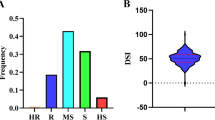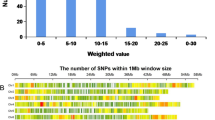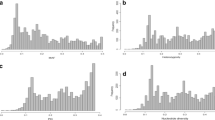Abstract
Key message
Association analysis techniques were used to identify and verify twelve single nucleotide polymorphisms (SNPs) associated with Fusarium graminearum resistance. Two novel candidate genes were obtained.
Abstract
Fusarium graminearum causes seed and root rot and seedling damping-off of soybean, leading to severe yield loss. Presently, the genetic basis of resistance to F. graminearum is elucidated in only four soybean accessions, which is not sufficient for resistance improvement. The objective of the present study was to identify the genome-wide genetic architecture of resistance to F. graminearum in landraces and cultivated soybeans based on a growth room evaluation. The resistance levels of 314 diverse accessions were tested, and 22,888 single nucleotide polymorphisms (SNPs) with a minor allele frequency of > 0.05 were developed using the specific-locus amplified fragment sequencing (SLAF-seq) approach. Twelve SNPs were identified as associated with F. graminearum resistance, and these SNPs were located at 12 genomic regions on eight chromosomes (Chr.) and could explain 5.53–14.71% of the observed phenotypic variation. One SNP, rs9479021, located on Chr.6, overlapped with qRfg_Gm06, the known QTL for resistance to F. graminearum. The other SNPs were novel and associated with resistance to F. graminearum. Nine novel candidate genes were predicted to contribute to resistance to F. graminearum according to the haplotype and transcript abundance analysis of the candidate genes. The identified markers and resistant cultivars are valuable for the improvement of resistance to F. graminearum.







Similar content being viewed by others
References
Acharya B (2014) Evaluation of soybean germplasm for additional sources of resistance and characterization of resistance towards Fusarium graminearum. M.S. Thesis, The Ohio State University, 2014
Acharya B, Lee S, Mian MAR, Jun TH, Mchale LK, Michel AP, Dorrance AE (2015) Identification and mapping of quantitative trait loci (QTL) conferring resistance to Fusarium graminearum from soybean PI 567301B. Theor Appl Genet 128:827–838
Akimoto-Tomiyama C, Tanabe S, Kajiwara H, Minami E, Ochiai H (2017) Loss of chloroplast localized protein phosphatase 2Cs in Arabidopsis thaliana leads to enhancement of the plant immunity and resistance to Xanthomonas campestris pv. campestris infection. Mol Plant Pathol. https://doi.org/10.1111/mpp.12596
Arias MM, Leandro LF, Munkvold GP (2013) Aggressiveness of Fusarium species and impact of root infection on growth and yield of soybeans. Phytopathology 103:822–832
Ban Q, Han Y, He Y, Jin M, Han S, Suo J, Rao J (2018) Functional characterization of persimmon β-galactosidase gene DkGAL1 in tomato reveals cell wall modification related to fruit ripening and radicle elongation. Plant Sci 274:109–120
Bradbury PJ, Zhang Z, Kroon DE, Casstevens TM, Ramdoss Y, Buckler ES (2007) TASSEL: software for association mapping of complex traits in diverse samples. Bioinformatics 23:2633–2635
Broders KD, Lipps PE, Paul PA, Dorrance AE (2007) Evaluation of Fusarium graminearum associated with corn and soybean seed and seedling disease in Ohio. Plant Dis 91(9):1155–1160
Brown NA, Urban M, Am VDM, Hammond-Kosack KE (2010) The infection biology of Fusarium graminearum: defining the pathways of spikelet to spikelet colonisation in wheat ears. Fungal Biol 114:555–571
Buerstmayr H, Steiner B, Hartl L, Griesser M, Angerer N, Lengauer D, Miedaner T, Schneider B, Lemmens M (2003) Molecular mapping of QTLs for Fusarium head blight resistance in spring wheat. II. Resistance to fungal penetration and spread. Tagtheoretical & Applied Geneticstheoretische Und Angewandte Genetik 107:503–508
Cao Y, Li S, Wang Z, Chang F, Kong J, Gai J, Zhao T (2017) Identification of major quantitative trait loci for seed oil content in soybeans by combining linkage and genome-wide association mapping. Front Plant Sci 8:1222–1232
Cheng P, Gedling CR, Patil G, Vuong TD, Shannon JG, Dorrance AE, Nguyen HT (2017) Genetic mapping and haplotype analysis of a locus for quantitative resistance to Fusarium graminearum in soybean accession PI 567516C. Theor Appl Genet 130:999–1010
Ellis ML, Broders KD, Paul PA, Dorrance AE (2011) Infection of soybean seed by Fusarium graminearum and effect of seed treatments on disease under controlled conditions. Plant Dis 95:401–407
Ellis ML, Wang H, Paul PA, Martin SKS, Mchale LK, Dorrance AE (2012) Identification of soybean genotypes resistant to and genetic mapping of resistance quantitative trait loci in the cultivar conrad. Crop Sci 52:2224–2233
Eun-Young H, Song Q, Jia G, Specht JE, Hyten DL, Jose C, Cregan PB (2014) A genome-wide association study of seed protein and oil content in soybean. BMC Genom 15:1–12
Guo B, Sleper DA, Nguyen HT, Arelli PR, Shannon JG (2006) Quantitative trait loci underlying resistance to three soybean cyst nematode populations in soybean PI 404198A. Crop Sci 46:224–233
Guo J, Dai X, Xu J, Wang Y, Bai P, Liu F, Duan Y, Zhang H, Huang L, Kang Z (2011) Molecular characterization of a Fus3/Kss1 type MAPK from Puccinia striiformis f. sp. tritici, PsMAPK1. PLoS ONE 6:e21895
Han Y, Zhao X, Cao G, Wang Y, Li Y, Liu D, Teng W, Zhang Z, Li D, Qiu L (2015) Genetic characteristics of soybean resistance to HG type 0 and HG type 1.2.3.5.7 of the cyst nematode analyzed by genome-wide association mapping. BMC Genom 16:1–11
Kottgen A, Pattaro C, Boger CA, Fuchsberger C, Olden M, Glazer NL, Parsa A, Gao X, Yang Q, Smith AV (2016) New loci associated with kidney function and chronic kidney disease. Das Gesundheitswesen 42:376–384
Lipka AE, Tian F, Wang Q, Peiffer J, Li M, Bradbury PJ, Gore MA, Buckler ES, Zhang Z (2012) GAPIT: genome association and prediction integrated tool. Bioinformatics 28:2397–2399
Liu S, Kandoth PK, Warren SD, Yeckel G, Heinz R, Alden J, Yang C, Jamai A, Elmellouki T, Juvale PS (2012) A soybean cyst nematode resistance gene points to a new mechanism of plant resistance to pathogens. Nature 492:256–260
Moreno JI, Martín R, Castresana C (2005) Arabidopsis SHMT1, a serine hydroxymethyltransferase that functions in the photorespiratory pathway influences resistance to biotic and abiotic stress. Plant J 41:451–463
Park YJ, Lee HJ, Kwak KJ, Lee K, Hong SW, Kang H (2014) MicroRNA400-guided cleavage of pentatricopeptide repeat protein mRNAs renders Arabidopsis thaliana more susceptible to pathogenic bacteria and fungi. Plant Cell Physiol 55:1660–1668
Pioli RN, Mozzoni L, Morandi EN (2007) First report of pathogenic association between Fusarium graminearum and soybean. Plant Dis 88:220
Pumphrey MO, Bernardo R, Anderson JA (2007) Validating the QTL for Fusarium head blight resistance in near-isogenic wheat lines developed from breeding populations. Crop Sci 47:200–206
Stasko AK, Wickramasinghe D, Nauth BJ, Acharya B, Ellis ML, Taylor CG, McHale LK, Dorrance AE (2016) High-density mapping of resistance QTL toward Phytophthora sojae, Pythium irregulare, and Fusarium graminearum in the same soybean population. Crop Sci 56:2476–2492
Sun X, Liu D, Zhang X, Li W, Hui L, Hong W, Jiang C, Ning G, Ma C, Zeng H (2013) SLAF-seq: an efficient method of large-scale de novo SNP discovery and genotyping using high-throughput sequencing. PLoS ONE 8:e58700
Sun M, Jia B, Yang J, Cui N, Zhu Y, Sun X (2017) Genome-Wide identification of the PHD-finger family genes and their responses to environmental stresses in Oryza sativa L. Int J Mol Sci 18:2005–2045
Wu J, Wang Y, Park SY, Sang GK, Ju SY, Park S, Gupta R, Kang KY, Sun TK (2016) Secreted alpha-n-arabinofuranosidase B protein is required for the full virulence of magnaporthe oryzaeand triggers host defences. PLoS ONE 11:e0165149
Wu L, Huang Z, Li X, Ma L, Gu Q, Wu H, Liu J, Borriss R, Wu Z, Gao X (2018) Stomatal closure and SA-, JA/ET-signaling pathways are essential for bacillus amyloliquefaciens FZB42 to restrict leaf disease caused by Phytophthora nicotianae in Nicotiana benthamiana. Front Microbiol 9:847–855
Xue AG, Cober E, Voldeng HD, Voldeng HD, Babcock C, Clear RM (2007) Evaluation of the pathogenicity of Fusarium graminearum and Fusarium pseudograminearum on soybean seedlings under controlled conditions. Can J Plant Path 29:35–40
Yuan N, Yuan S, Li Z, Zhou M, Wu P, Hu Q, Mendu V, Wang L, Luo H (2018) STRESS INDUCED FACTOR 2, a leucine-rich repeat kinase regulates basal plant pathogen defense. Plant Physiol 176:3062–3080
Yun Y, Liu Z, Zhang J, Shim W, Chen Y, Ma Z (2014) The MAPKK FgMkk1 of Fusarium graminearum regulates vegetative differentiation, multiple stress response, and virulence via the cell wall integrity and high-osmolarity glycerol signaling pathways. Environ Microbiol 16:2023–2037
Zhang JX, Xue AG, Zhang HJ, Nagasawa AE, Tambong JT (2010) Response of soybean cultivars to root rot caused by Fusarium species. Can J Plant Sci 90:767–776
Zhang H, Li C, Davis EL, Wang J, Griffin JD, Janice K, Song BH (2016) Genome-wide association study of resistance to soybean cyst nematode (Heterodera glycines) HG Type 2.5.7 in wild soybean (Glycine soja). Front Plant Sci 7:1214–1246
Zhao X, Teng W, Li Y, Liu D, Cao G, Li D, Qiu L, Zheng H, Han Y, Li W (2017) Loci and candidate genes conferring resistance to soybean cyst nematode HG type 2.5.7. BMC Genom 18:462–472
Zhou Z, Jiang Y, Wang Z, Gou Z, Lyu J, Li W, Yu Y, Shu L, Zhao Y, Ma Y (2015) Resequencing 302 wild and cultivated accessions identifies genes related to domestication and improvement in soybean. Nat Biotechnol 33:408–414
Acknowledgements
This study was conducted in the Key Laboratory of Soybean Biology of the Chinese Education Ministry, Soybean Research & Development Center (CARS), and the Key Laboratory of Northeastern Soybean Biology and Breeding/Genetics of the Chinese Agriculture Ministry and was financially supported by the Chinese National Natural Science Foundation (31671717, 31471517), National Key R & D Project for Crop Breeding (2016YFD0100304), the National Supporting Project (2014BAD22B01), the Youth Leading Talent Project of the Ministry of Science and Technology in China (2015RA228), the National Ten-thousand Talents Program, Heilongjiang Provincial Project (GX17B002, JC2018007, C2018016), the ‘Academic Backbone’ Project of Northeast Agricultural University (15XG04, 17XG22), Postdoctoral Fund in Heilongjiang Province (LBH-Z15017, LBH-Q17015), and the ‘Youth Innovation Talent’ Project of the general undergraduate universities in Heilongjiang province (UNPYSCT-2016145).
Author information
Authors and Affiliations
Contributions
CJZ and XZ conceived the study and contributed to population development. YFQ, WLT, LJQ, and HKZ contributed to genotyping. ZHW contributed to phenotypic evaluation. YPH and WBL contributed to experimental design and writing paper. All authors contributed to and approved the final manuscript.
Corresponding authors
Ethics declarations
Conflict of interest
The authors declare that they have no conflict of interest.
Ethical standards
The authors have adhered to the ethical responsibilities outlined by Theoretical and Applied Genetics.
Additional information
Communicated by David A. Lightfoot.
Chanjuan Zhang and Xue Zhao have contributed equally to this work.
Electronic supplementary material
Below is the link to the electronic supplementary material.
Rights and permissions
About this article
Cite this article
Zhang, C., Zhao, X., Qu, Y. et al. Loci and candidate genes in soybean that confer resistance to Fusarium graminearum. Theor Appl Genet 132, 431–441 (2019). https://doi.org/10.1007/s00122-018-3230-3
Received:
Accepted:
Published:
Issue Date:
DOI: https://doi.org/10.1007/s00122-018-3230-3




